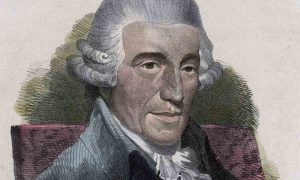Johann Sebastian Bach would probably be astounded at his reputation as one of the greatest composers – perhaps the greatest composer – of all time. In his own day, he was famed chiefly for his keyboard skills, and much of his time was spent writing for the churches where he worked. Yet, when it came to the quality of his work, he produced more jewels than Bvlgari. Bach composed for every musical genre of his time, apart from opera, and ultimately his aim was to glorify God. He said, “Music’s only purpose should be the glory of God and the recreation of the human spirit.” Scroll down to discover our selection of the best Bach works featuring 10 masterpieces by the great composer.
Listen to the best of Bach on Apple Music and Spotify.
Brandenburg Concertos
Many Baroque composers wrote dozens, or even hundreds, of concertos but Bach managed to sum up the entire genre with only six, each featuring a different line-up of soloists with a wide range of moods and even structures (shocking in an era when concertos were supposed to have three movements: fast-slow-fast). So we leap from the dizzying heights of the outlandishly difficult trumpet-writing that colours the second Brandenburg Concerto, to No.6, which gets its dark shades from the lack of violins. And, for pure virtuosity, try the brilliant No.5 in which flute, violin and harpsichord steal the limelight.
Four Orchestral Suites
Alongside the concerto, the other genre in vogue in Bach’s time was the orchestral suite (or “overture” as he called it). Whereas the concerto came out of an Italian tradition the suite was, in origin, a sequence of French dances. While all four of Bach’s have a kind of courtly nobility beyond that they range enormously: from the gracious sequence of dances in the First; via the catchy ‘Badinerie’ for flute that ends the Second; to the trumpets-and-drums opening of the Third; and finally the heady grandeur of the Fourth, easily one of the best Bach works, rivalling Handel’s most opulent creations in terms of pure pomp.
St Matthew Passion
Passions are large-scale choral works telling of the suffering and death of Christ, and none come finer than those of Bach, of which two have come down to us: the St John and the St Matthew. The latter is one of the great icons of music, but after Bach’s death, it went unperformed for nearly 80 years until a young Felix Mendelssohn reintroduced it to the world. Its combination of scale, solemnity and touching humanity (encapsulated in the gravely sorrowful aria ‘Erbarme Dich’ for alto and violin) gives it an enduring appeal that captivates believers and non-believers alike.
Cantata No.21
Bach’s cantatas (nearly 200 sacred and a good handful of secular ones survive) are all the more remarkable when you think that this was real bread-and-butter stuff, produced for the church services every week. This meant they had to be performable without much rehearsal; so either the congregation endured some pretty ropey playing, or Bach’s musicians were out of the ordinary, as they’re far from easy. Cantata No.21 is one of the most beautiful. Its text is a popular subject in the Lutheran tradition: “Has God forsaken me? Phew, no he hasn’t.” It’s unusually large-scale and, among the best Bach works, demonstrates that no one expresses anguish more deliciously than Bach.
Organ Fantasia and Fugue In G Minor, BWV542
Bach was particularly admired for his keyboard skills, not least his knack for improvisation; much of his organ music probably started out life as just that – a doodle turned into something mighty. Leaving aside the most famous organ work of all, the Toccata and Fugue in D minor (which some doubt is by Bach at all), one of the most brilliant works is his Fantasia and Fugue In G Minor. The free-flowing Fantasia has an angular beauty and a dark-hued mood that comes from Bach’s liking for crunchy dissonance, while the Fugue is a tour de force that builds to a firmament-shaking climax.
The Well-Tempered Clavier – The 48
Bach was not merely one of the greatest composing geniuses in history; he was also a devoted family man, and frequently wrote keyboard music as a teaching aid for his many children. The Well-Tempered Clavier is a set of preludes and fugues in all 24 major and minor keys (48 works in all). If that sounds a little dry, then just remember this is Bach we’re talking about. The 48 are just as gripping to listen to as they are to play, earning their place among the best Bach works. And, given that this music was never intended for an audience, it’s hardly surprising that there’s a sense of intimacy about even the most extended and grandiose of the pieces.
Goldberg Variations
Ultimately with Bach, you can either spend ages trying to analyse why his music is so endlessly compelling or, as with the Goldberg Variations (purportedly written to soothe an insomniac nobleman to sleep) you can just enjoy it. Designed for harpsichord, but equally enthusiastically claimed by pianists, it consists of a lyrical theme with 30 variations, lasting about an hour. Bach puts the theme through myriad permutations of mood and speed, and when the theme returns unadorned at the end, the sense of a momentous journey is complete.
Six Cello Suites
While it’s easy enough for the keyboard to stand alone, string instruments have a harder time of it. Bach’s solo Cello Suites are immensely difficult, not least because he was determined to make the instrument sound self-sufficient. They vanished for years from the repertoire, only to be rediscovered and subsequently celebrated when the great Catalan cellist Pablo Casals began to play them, proving that they were not, as previously thought by some, merely studies. The suites have daunted players and delighted audiences ever since. They turn the cello into a veritable orchestra, and range from the gloriously affirmative No.1, via the introspection of No.2, to the brilliant, high-flying Sixth.
Violin Sonatas and Partitas
Violinists have no need to envy the Cello Suites, since Bach left them an equivalent solo work: the Sonatas and Partitas. The most famous of them is the ‘D Minor Partita’, with its fiendish and epic final ‘Chaconne’, in which a simple theme is varied no fewer than 64 times, to extraordinary emotional effect. Equally effective is the ‘E Major Partita’, which dances in with an irrepressible spirit that is rarely threatened during the remaining movements. The listener never desires accompaniment with any of these pieces, as the violin is placed in the spotlight so compellingly.
Concerto In D Minor For Two Violins
Bach didn’t leave many solo concertos, but this one is a gem, easily up there with the best Bach works of all time. Featuring two violinists with a simple string-and-harpsichord accompaniment, it is particularly beloved for its rhapsodic slow movement (shamelessly plundered by myriad film directors for moments of high emotion), in which the two soloists entwine confidingly, sounding more like singers than instrumentalists. This contrasts with the energetic outer movements in which the two players brilliantly spark off each other. It’s hardly surprising that great violinists throughout history have paired up for this irresistible double act.
Discover more of our articles collecting the best works of composers through the ages.




